Decisive Edge Newsletter | Land | October 2023
Newsletter Sponsors:
How Serbia’s defence industry is blending old and new technologies
Every two years, the Republic of Serbia holds the Partner defence exhibition in Belgrade to show potential customers the country’s latest defence developments, with the land sector firmly in focus.

As is customary, several systems were shown for the first time at Partner 2023, with some being brand new while others are upgrades of older platforms to extend their operational lives.
Many have been developed under the leadership of the Serbian Military Technical Institute, while Yugoimport is responsible for marketing products produced by domestic industry as well as importing weapons and equipment for the Serbia armed forces.
Taking just one example, Serbia has developed to the prototype stage a Hybrid Mobile Air Defence System (HMADS) based on an M-84 (a local version of the Russian T-72 with many modifications) MBT chassis.
The original turret is replaced by a brand new one armed with two Bofors 40mm L70 cannon with a pod of two surface-to-air missiles (SAMs) on either side. These latter can be the locally developed RLN-TK with infra-red (IR) homing (IR) or the RLN-RF with a semi-active radar seeker.
Both SAMs have a two-stage solid propellant motor with a launch weight of 110kg and a claimed maximum range of 15km and effective altitude of up to 8km.
Mounted between the weapons is an optical sighting system consisting of a Gen III cooled thermal imager, day camera and laser rangefinder coupled to a ballistic computer. The guidance radar or illuminator for the SAM is installed on the front of the turret.
The surveillance radar is mounted on the turret roof towards the rear and is claimed to be able to track aircraft at up to 75km and small commercial-type drones out to 5km.

Initial trials have commenced with the L70 cannon, which are capable of firing proximity-fuzed or airburst ammunition for the air defence role or high-explosive rounds for direct fire.
In a typical deployment the SAM would be used to engage aircraft at long range with the 40mm guns being used for closer targets.
Serbia’s long tradition of modernising older equipment has continued with the Russian BRDM-2 4x4 reconnaissance vehicle, which has been upgraded to the BRDM-2MS standard and is now operational with the Serbian Army.
To provide greater internal volume, the two powered belly wheels either side have been removed which allows for access doors to be fitted and the original petrol engine is replaced by a more fuel-efficient diesel.

Above: An upgraded BRDM-2MS reconnaissance vehicle showing the new side door, appliqué armour package and turret-mounted sighting system. (Photo: author)
The vehicle still retains its amphibious capability as new waterjets have been fitted on either side at the rear to replace the single one in the middle of the hull.
Main armament is a turret fitted with 14.5mm and 7.62mm machine guns (MG) which are now stabilised and laid onto the target using a roof-mounted sighting system with day/thermal cameras and a laser rangefinder.
The BRDM-2MS also has cameras for situational awareness across 360°, a land navigation system and a new communications package.
The original all-welded-steel hull has been fitted with an appliqué armour package and a replacement wheel is carried at the rear with a device to lower this to the ground.
The 4x4 also hosts a small UAV to carry out reconnaissance while the BRDM-2MS is under cover.

There is an increasing trend to install 120mm mortar systems on lighter platforms and Serbian company PPT Namenska has joined in, developing to the prototype stage the Semy 120mm mobile mortar system or M120M.
This is based on a locally manufactured Zastava 4x4 platform with a forward control cab and central tyre pressure regulation system for improved cross-country mobility. It has a gross vehicle weight of 2,000kg which includes crew and ammunition.
When travelling the smoothbore mortar is in the horizontal position and deployed over the rear arc using a hydraulic ram until the large baseplate comes into contact with the ground to provide a stable firing platform.
Powered traverse is 60° left and right with elevation from +45 to 85° and maximum range firing an unassisted mortar bomb is quoted as 6.2km with a top rate of fire of up to 11 per minute. The mortar is coupled to a computerised fire control system for greater accuracy.
A total of 40 120mm mortar bombs are carried in two lots of 20 on either side of the cab rear.
This system is claimed to be able to come into action in 33 seconds and move out of action in 16 seconds improving its survivability. A trailer-mounted version has also been developed.
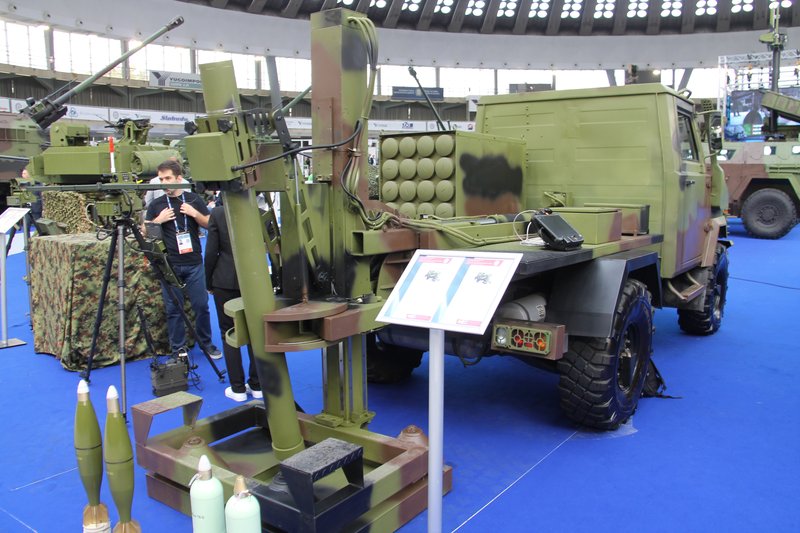
Above: The Semy 120mm mobile mortar system mounted on a Zastava truck with baseplate lowered to the ground. (Photo: author)
Next, following the success of the first-generation Miloch 4x4 in home and export markets, Serbia has developed the Miloch 2 which is described as a Multirole Armoured Tactical Vehicle (MATV) with more volume, payload and protection.
Miloch 2 has a gross vehicle weight of 18t of which 2.5t is payload, including crew and weapons. In addition to commander and driver it can carry eight dismounts who can rapidly exit via side doors or a power-operated rear ramp.
The power pack is a 6.7l diesel developing 338hp coupled to automatic transmission and a two-speed transfer case which gives a maximum road speed of 100km/h. Texelis provide the new-generation T750 axles.
Standard equipment includes a central tyre pressure regulation system, front-mounted winch and cameras for situational awareness.
A variety of weapon stations can be mounted on the roof including a remote-controlled turret with 20mm M55 cannon, 7.62mm M86 coaxial MG, twin launchers
on the right for Malyutka anti-tank guided weapons, a roof-mounted 30mm M93 grenade launcher and banks of 82mm smoke grenade launchers.
Weapons are laid onto the target via a flat panel display inside, using a roof mounted-sighting system fitted with day/thermal cameras and a laser rangefinder plus missile guidance package.
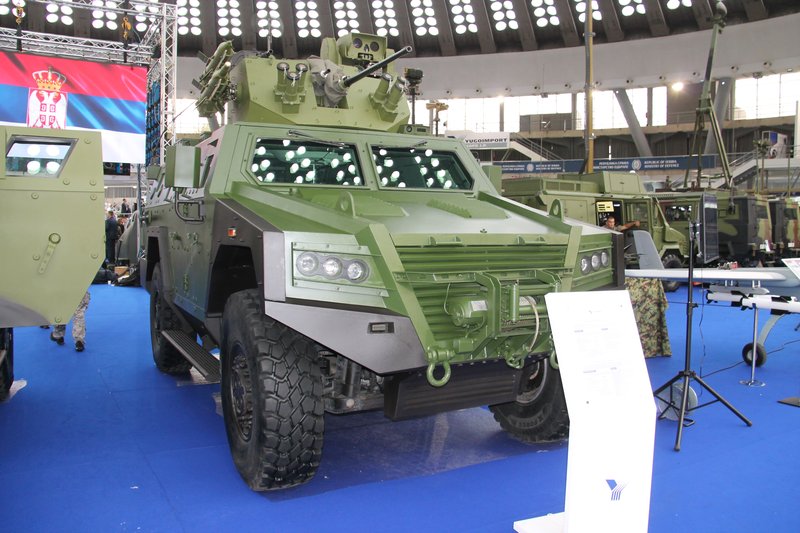
Above: The Miloch 2 4x4 fitted with a remote-controlled turret armed with a 20mm cannon, 7.62mm machine gun, two missiles and a 30mm M93 automatic grenade launcher. (Photo: author)
Returning to air defence, the original Pasars system, based on a 6x6 chassis with a protected crew compartment at the front, was armed with a Bofors 40mm L70 cannon for use in air defence and ground suppression missions.
The latest version shown at Partner 2023, the Pasars New Generation V4 hybrid gun/missile system has a step-change in capability.
In addition to the L70 it is armed with a pod of two MBDA Mistral 3+ SAMs, two Strela-2M or 2MA SAMs and a pair of Malyutka 2T5s plus a counter-UAV jammer.
Malyutka 2T5 is an improved Serbian version of the Russian missile with range increased to 5,000m and fitted with a tandem high-explosive anti-tank (HEAT) warhead to neutralise targets fitted with explosive reactive armour (ERA). However, this missile has yet to enter production.
Aerial targets are located using four RADA RPS-42 AESA antennas which cover 90° in azimuth and 80° in elevation.
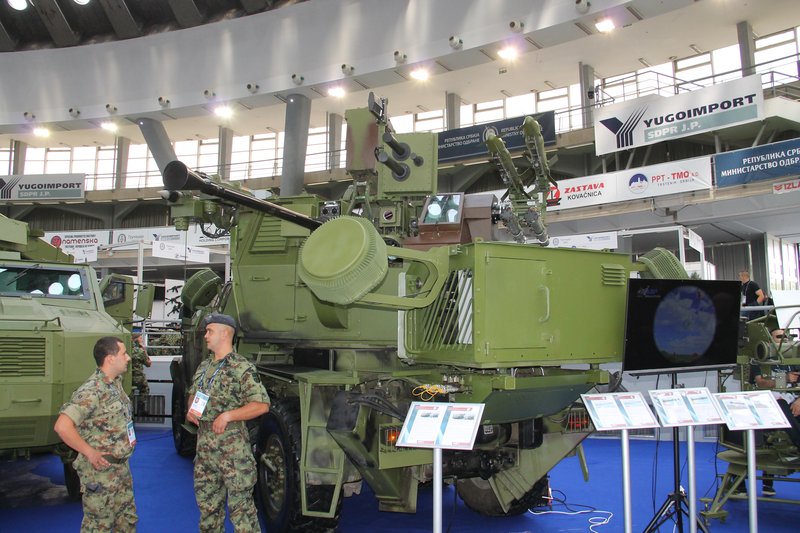
Above: This view of the Pasars NG V4 air defence system clearly shows some of the RADA radar antennas which provide coverage through a full 360°. (Photo: author)
The platform is fitted with an auxiliary power unit and to provide a more stable firing platform four stabilisers are lowered to the ground.
In addition to being used as a standalone weapon system it can also be repurposed as a command vehicle to relay target information to other air defence assets.
Lastly, Serbia has developed the M20 Mine-Resistant Ambush-Protected (MRAP) vehicle based on a 6x6 chassis with fully protected engine compartment at the front and crew compartment extending to the rear.
It has a gross vehicle weight of 25t and in addition to commander, driver and gunner can carry two dismounts who can rapidly exit via the rear doors.
According to officials at the show, the V-shaped lower hull has been designed to NATO STANAG 4569 Level 3A and 3B standard while ballistic protection is stated to be to STANAG 4569 Level 4.
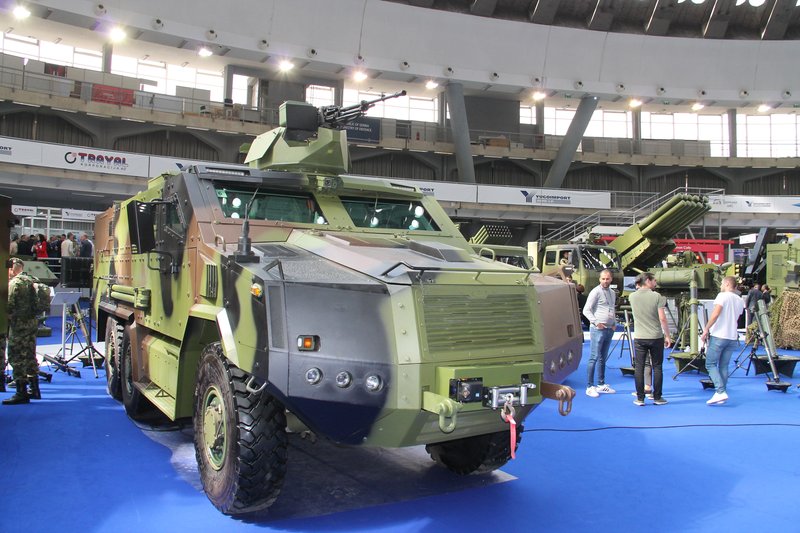
Above: The M20 6x6 MRAP can be fitted with a variety of roof-mounted weapons. (Photo: author)
For enhanced crew survivability the foldable dismount seats are attached to the vehicle’s roof, absorbing shocks and vibration via rails and springs. An NBC system and fire detection and suppression system is fitted as standard.
Power pack consists of a diesel engine plus six-speed automatic transmission and two-speed transfer box with central tyre inflation and winch fitted as standard. As usual there are a number of options including a front-mounted dozer blade.
Will reliance on Russian supply chain scupper Lazar APC upgrades?
The Lazar 8x8 was originally introduced into service with Serbian forces fitted with a roof-mounted unstabilised remote controlled weapon station armed with a 12.7mm machine gun.

Above: The Lazar 3 8x8 fitted with a remote weapon station armed with two 30mm cannon laid onto the target by a day/night sighting system. (Photo: author)
For trial purposes the Lazar 3 has now been integrated with a remote-controlled weapon station (RCWS) armed with two 30x210mm single-feed cannon each provided with 110 rounds of ready ammunition, with a claimed maximum range in the ground-to-ground role of 2,000m.
A prototype Lazar 3M has also been completed, which is equipped with a Russian RCWS armed with a stabilised 30mm dual-feed cannon and 7.62mm coaxial machine gun (MG) laid onto the target via charge-coupled device (CCD) camera, infra-red (IR) camera with laser rangefinder and automatic tracker.
The cannon is provided with 300 rounds of ammunition (200 high explosive and 100 armour-piercing tracer). This turret was modified in Serbia but it is understood that no additional examples will come from Russia in the immediate future.
The M in the designation indicates the vehicle has an additional armour package and anti-mine protection which has increased its weight of around 30t. Unlike earlier Lazars the 3M does not have any bulletproof side windows and associated firing ports in the hull.
On the plus side, the Lazar 3M has a new-generation power pack, with a diesel engine coupled to a fully automatic transmission with independent suspension system.
Serbia has also completed the first example of the Lazanski 8x8 infantry fighting vehicle which has a maximum weight of 26-36t which depends on the weapon station and armour package.
Power pack is a Caterpillar C13 diesel developing 711hp coupled to an Allison 4000P six-speed automatic transmission. A height management system fitted as standard, as are Texelis T900 axles.
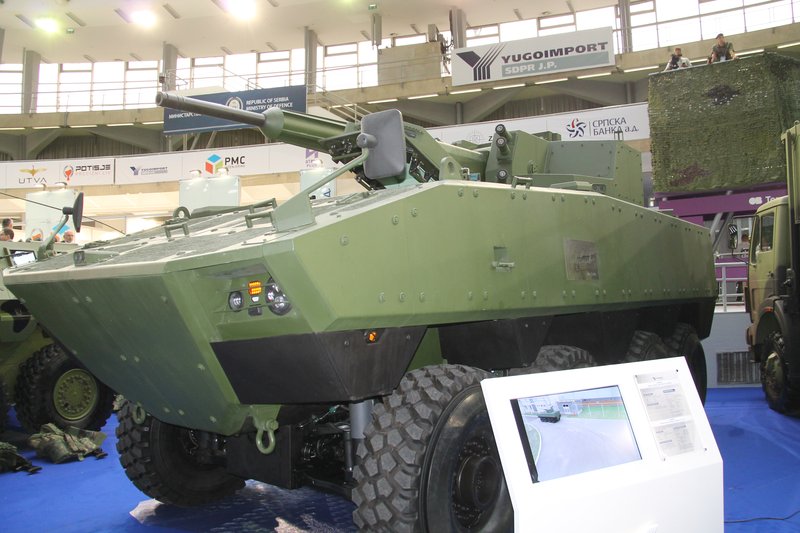
Above: A Lazanski 8x8 IFV fitted with remote controlled weapon station armed with 57mm gun and 7.62mm coaxial machine gun. (Photo: author)
Ballistic protection is to STANAG 4569 Level 4 but under development is an upgrade to Level 5 and 6, while mine protection is STANAG 4569 Level 4a/4b. Like the Lazar 3M, the Lazanski does not have any firing ports.
Standard equipment includes an inertial navigation system to thwart GPS jamming, a battle management system, air conditioning and CBRN protection. The crew is provided with anti-blast seats.
The first example is fitted with an RCWS armed with a 57mm gun and 7.62mm coaxial MG and is understood not to have yet commenced firing trials.
Serbia pursues multiple paths to long-range precision fires
Serbia has just completed the first example of its 155mm/52cal NORA New Generation (NG) howitzer, which is expected to start firing trials early in 2024.
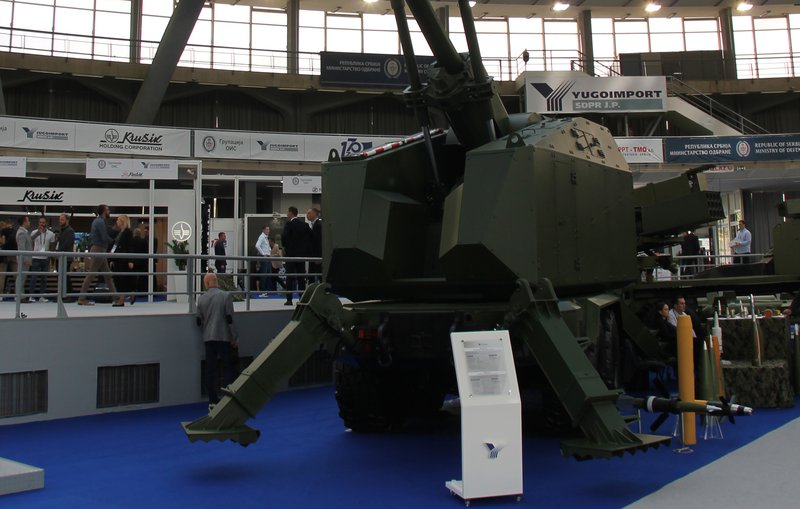
Above: The Latest Serbian NORA NG 155mm/52cal self-propelled artillery system based on a MAN 8x8 chassis. (Photo: author)
The artillery system, also known as Perun, is based on a MAN 8x8 truck chassis with a fully protected four-door cab and protected remote-controlled turret incorporating a reinforced barrel with a 23l chamber that meets the NATO Joint Ballistic Memorandum of Understanding (JBMoU).
A key feature of the system is that the magazine holds a total of 30 artillery projectiles and associated charges, with an additional six 155mm rounds on the vehicle.
Maximum range depends on projectile/charge combination but is 32.5km for an extended range full bore (ERFB) round, 41.5km for ERFB base bleed and 52km for a Velocity Enhanced Artillery Projectile.
At the Partner 2023 exhibition in Belgrade, a China North Industries Corporation (NORINCO) 155mm GP155A laser-guided projectile was shown alongside the NORA NG system but rapidly removed.
The system can carry out multiple-round simultaneous-impact fire missions in which three 155mm projectiles will hit the target at the same time at a range of 30km.
As the NORA NG has a computerised fire control system and inertial navigation it can carry out independent fire missions and according to officials can open fire within 60 seconds of coming to a halt and redeploy in 30 seconds after the mission has been completed.
The turret is normally fired over the rear arc with a traverse of 30° left and right with elevation from -5 to +65°.
To provide a more stable firing platform four hydraulically operated stabilisers are lowered to the ground, two on either side. The system is operated by a crew of four people from the protected cab and has a combat weight of around 40t.
The earlier NORA B-52, which is also JBMoU compliant, is based on an KamAZ 8x8 platform with export customers known to include Bangladesh, Cyprus, Kenya and Myanmar. This has a crew of five.
Its most recent iteration is the M21 which is based on a MAN chassis and an automatic loader that can handle bi-modular charges rather than the original Serbian natures.
Serbia has also developed the Alexander artillery system to prototype stage, which also has a 155mm/52cal ordnance but its unmanned turret only has 12 rounds and once expended another 12 can be loaded automatically giving a total of 24 carried. This has been marketed with a 23 or 25l chamber.
Further out in the future is a NORA Ultra Long Range based on an 8x8 platform with a new 155mm/60cal barrel with a higher chamber volume which will fire a new generation of ammunition with a maximum range of some 70km.
This will include a new 155mm high explosive fin-stabilised discarding sabot projectile with an advanced filling and terminal guidance.
In addition to new artillery systems, Serbia is also investing in ammunition developments including the 155mm M19 projectile which has a new streamlined shape and a thermobaric filling. A 155mm course-correct fuze is also being developed which uses INS/GPS guidance and claimed to give a circular error of probability of less than 30m.

Heavy IFV (Poland)
This month’s featured programme entry from Shephard Defence Insight
Snapshot
Due to the perceived threat from Russia and the conflict in Ukraine, Poland has accelerated and expanded its plans to modernise its mechanised forces. Although Warsaw is progressing its NBPWP Borsuk programme, media reports in 2022 indicated that the country was exploring options for an off-the-shelf IFV purchase to meet urgent military requirements.
Defence Insight forecasts that the Polish government will seek a $1.26 billion purchase of approximately 350 domestically produced Heavy IFVs.
A spokesman from Hanwha Defence at DSEI 2023 confirmed that negotiations had begun with the Polish MoD.
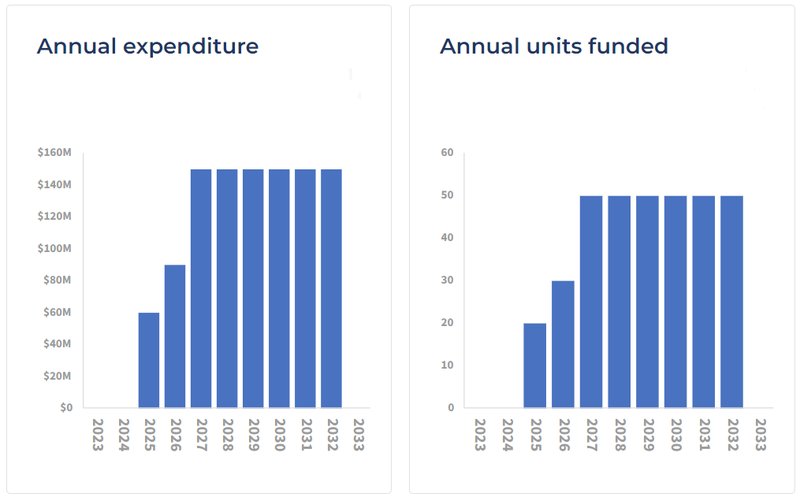
Requirements
Poland is already moving forward with the NBPWP Borsuk programme, 1,400 of which will be acquired in total. In May 2022, Polish officials noted that the country was exploring options for an additional off-the-shelf IFV purchase that would be a stopgap measure.
In August 2022, Shephard Media reported that the manufacturing facilities designated for the Borsuk would be fully occupied for a period even when planned extensions are taken into account. Polish officials, however, stress that the country's military requirement is urgent and the Borsuk may not be a mature platform at the outset.
Furthermore, Poland purchased M1A1 and M1A2 SEPv3 MBTs to fulfil an emergency need, increasing the requirement for accompanying modern armoured vehicles.
Potential Competitors
During the Eurosatory 2022 exhibition, Hanwha officials noted that the company had the capability to supply Poland with the K21 or AS21 Redback IFVs. In October 2022, South Korean media reported that Poland was considering the acquisition of the AS21. The Polish Army is expected to trial the AS21 in 2023.
It is understood that Poland is looking for a heavier IFV to accompany Borsuk, which is a lighter platform. As such, Defence Insight considers the AS21 Redback as a likely candidate especially when equipped with a domestically built Polish turret.
Early platforms could be produced in South Korea following the prior start of production of the AS21 for Australia before a domestic Polish manufacturing hub can be established.
Programme Requirements
Following the signing of a framework agreement for 1,000 NBPWP Borsuk IFV and 400 support variants by Poland in February 2023, a Polish Armament Agency spokesperson revealed Huta Stalowa Wola (HSW) was the frontrunner for a new Heavy IFV contract.
Based on the K9/AS21 chassis with a ZSSW-30 turret, this new IFV is intended to deploy alongside Poland's recently ordered M1 Abrams MBTs. The prototype should be ready to test in December 2023. Trials will be conducted by the 18th Mechanised Division, which is re-equipping with the Abrams.
Forecast Methodology
Defence Insight forecasts that Poland will seek to procure approximately 350 units.
Data from major NATO-member European militaries suggest that these counties had a median MBT/IFV ratio of 0.418 in 2022. Currently, Poland's off-the-shelf MBT procurement includes three programmes and a total of 546 tanks which implies a requirement of approximately 1,300 IFVs.
The Borsuk programme, on the other hand, is expected to deliver 1,000 IFV units in total with Defence Insight forecasting a further demand for at least 350 additional Heavy IFVs to work in conjunction with the newly formed Abrams units.
The programme has a forecasted total value of $1.26 billion assuming Poland will pay 20% support costs on top of the total procurement value.
The programme has a forecasted unit cost of $3 million which was derived from Defence Insight data on potential competitors.
Don't want to miss out on future Decisive Edge content? Make sure you are signed up to our email newsletters.













